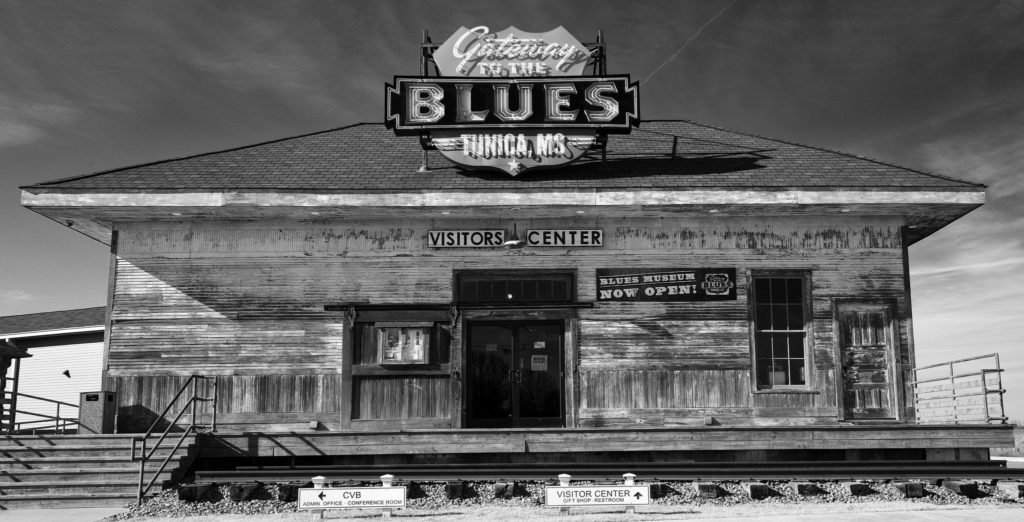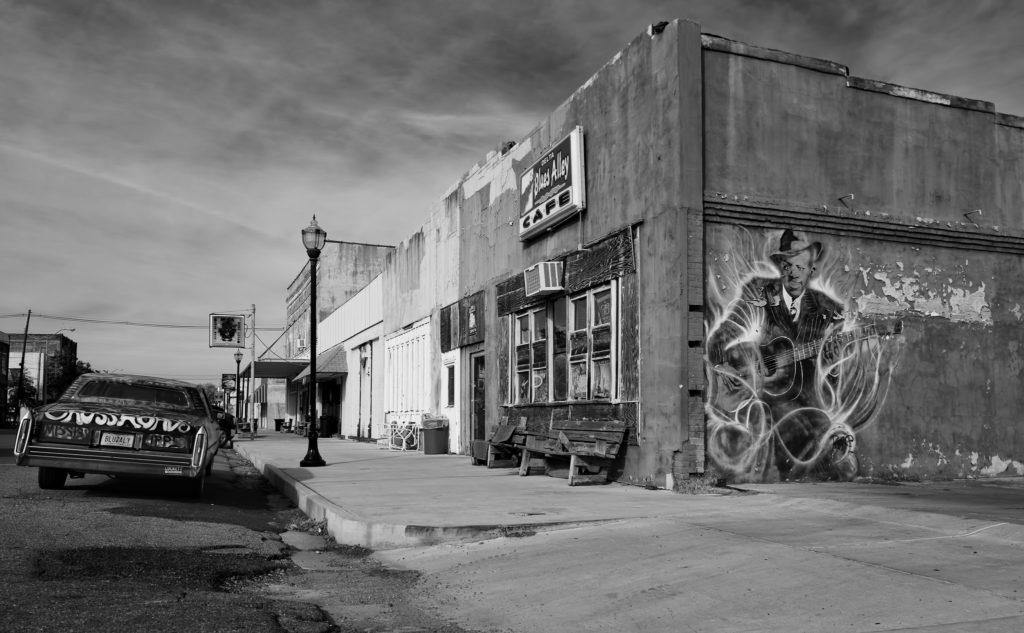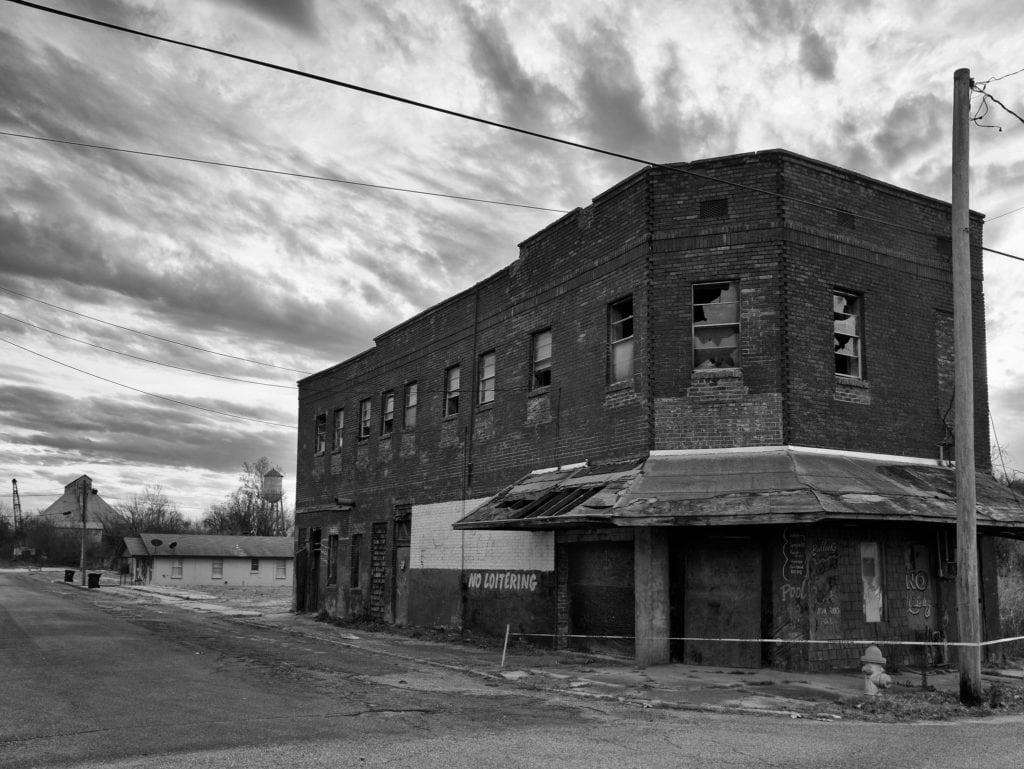Into Blues Country
It was in the Mississippi Delta that sharecroppers first fused the rhythms and tones of Africa with the scale and instruments of American folk music to produce the blues. This new musical form was was first described by touring musician WC Handy in Memphis in 1903. By the 1920s the first blues records were being made. By the late 1920s Charley Patton had emerged from an anonymous folk tradition to become a blues superstar. He was followed in the 1930s by many more stars, most notably the hugely influential Son House and the legendary Robert Johnson (though Robert was little known in his own lifetime). The Delta blues started to move beyond the South, up the Mississippi river into the Midwest, aided in its spread by the phenomenon known as the “juke joint”. This was an informal establishment, sometimes a “shotgun shack”, that provided music, dancing, gambling, and drinking for the sharecroppers, whose lives were exceedingly hard. In the 1940s the blues evolved into electric, urban forms such as Chicago Blues, popularised by Muddy Waters, which later formed the basis of rock ‘n roll.
Highway 61
 The City of Clarksdale is located in the heart of the Delta, at the intersection of Highways 61 and 49. This is the crossroads famed for Robert Johnson’s legendary Faustian pact. From Memphis it is about an hour and a half’s drive down the “Blues Highway” (Highway 61) which follows the Mississippi river for much of its route. Highway 61 is much more than a road in the US; it is second only to Route 66 as the most famous highway in American music. Many blues artists have recorded songs about this storied road; “Honeyboy” Edwards, Big Joe Williams, and Mississippi Fred McDowell amongst them. Bob Dylan said of it “Highway 61, the main thoroughfare of the country blues, begins about where I began. I always felt like I’d started on it, always had been on it and could go anywhere, even down in to the deep Delta country. It was the same road, full of the same contradictions, the same one-horse towns, the same spiritual ancestors … It was my place in the universe, always felt like it was in my blood.” Needless to say, I was happy to take the Blues Highway to Clarksdale.
The City of Clarksdale is located in the heart of the Delta, at the intersection of Highways 61 and 49. This is the crossroads famed for Robert Johnson’s legendary Faustian pact. From Memphis it is about an hour and a half’s drive down the “Blues Highway” (Highway 61) which follows the Mississippi river for much of its route. Highway 61 is much more than a road in the US; it is second only to Route 66 as the most famous highway in American music. Many blues artists have recorded songs about this storied road; “Honeyboy” Edwards, Big Joe Williams, and Mississippi Fred McDowell amongst them. Bob Dylan said of it “Highway 61, the main thoroughfare of the country blues, begins about where I began. I always felt like I’d started on it, always had been on it and could go anywhere, even down in to the deep Delta country. It was the same road, full of the same contradictions, the same one-horse towns, the same spiritual ancestors … It was my place in the universe, always felt like it was in my blood.” Needless to say, I was happy to take the Blues Highway to Clarksdale.
Gateway to the Blues Museum, Tunica
The Gateway to the Blues Visitors Center and Museum was my first stop. It lies directly on Highway 61 between Memphis and Clarksdale, close to Tunica’s casino area (Mississippi’s Las Vegas), and less than an hour from Memphis. The Museum is housed in a beautifully restored one-room, nineteenth century train depot, and serves as a gateway to the blues music scene across the the Mississippi Delta. It was, for me, more impressive on the outside that in, but that is no criticism – for a photographer that is often the case and it is a really iconic building. Inside there is a great collection of guitars, information on the hundred or so blues trail markers, and a good selection of blues merchandise and literature. I got talking to the staff at the museum as I was buying some merchandise (a Robert Johnson T shirt), and admitted to being an amateur musician. In fact being a musician was my first choice of career and I’ve always felt a little regret that I ‘sold out’ to pursue a more conventional job. I characterised this a little thoughtlessly, given where I was, and what I was buying there. I used the phrase ‘sold my soul to the devil’ to describe the (alleged) sell out. I’ve used the description before more than once before and received a smile as a result, but that wasn’t the case this time. Note to self – never make reference to selling your soul to the devil in the Deep South! One of the women nearly jumped out of her skin and the other looked most discomforted. I assured them that this was not literally what I did, and that it was just a figure of speech, and apologised for alarming them.
Speaking of my music, there’s a link to one of my blues tracks below. I think the song is well crafted enough, but the recording is very much demo quality at best and the lead really needs re-doing as I just went at it full tilt and lost the plot a bit – I am by no means a shredder. That said, I know I’ll never re-record it. I have too many other tunes in my head that I need to get down, some of which I wrote many years ago. I rarely get time to record, which isn’t helped by the inordinate amount of time I take to lay down a track on my old school 16 track recorder.
The Delta Blues Museum
I headed into Clarkdale itself, to the Delta Blues Museum. It is located in an old freight depot built in 1926. The area it is situated in was deserted and a quite run down, and I was convinced that I was in the wrong place until I saw the Museum’s sign. It was established in 1979 as the first museum devoted to blues and moved to its current location 20 years later. Bearded guitar ace Billy Gibbons of ZZ Top played a big role in raising funds for the museum. He was also instrumental in bringing the largest and most important exhibit to the museum – the cabin where Muddy Waters once lived on the nearby Stovall plantation. The museum covers the who’s-who of the blues very comprehensively and I wandered around it contentedly for quite some time.
 Blues Alley and Robert Johnson
Blues Alley and Robert Johnson
The Delta Blues Museum is at number 1 Blues Alley. Right across the street is the Delta Blues Cafe, which has an old Cadillac art car parked outside and a haunting, peeling mural of Robert Johnson, the most potent legend of the blues, on the side of the building.
It was at crossroads of Highways 49 and 61 in Clarksdale, where legend has it that Robert did a deal with the devil, who retuned his guitar in exchange for his soul. Formally a harmonica player and an indifferent guitarist, he returned with such a mastery of the blues that Son House and other older guitarists were incredulous. The story circulated that Robert had sold his soul to the devil at the crossroads. “Cross Road Blues” and “Me and the Devil Blues”, have both contributed to the myth of a pact with Lucifer. In the latter song, Satan visits Robert early in the morning. “Hello Satan,” sings Robert, “I believe it’s time to go.”
Graveyard Versus Crossroads
In fact Robert had met and moved in with guitar player Ike Zimmerman and his family, and Ike became his tutor. They practised together amongst the tombstones in the quiet of a local graveyard. It is quite likely that the origin of the Faustian story came from another blues musician, named Tommy Johnson (no relation). Tommy cultivated a rather dark image to help promote his act. As part of this, according to his brother, he claimed to have sold his soul to the devil at a crossroads in exchange for mastery of the guitar. Robert made no such claim. Tommy lived until 1956, whereas Robert only lived until 1938 (he was 27 when died and so later became a member of the 27 club.) Almost nothing was known about Robert until much later when some serious research was done and the story attached to the more mysterious figure. When I first heard of Robert in the 1980’s there were no known photographs of him. Even today there are only two. Robert recorded just 29 songs between 1936 and ‘37. Like him, most of these tunes have attained mythic status: “Cross Road Blues,” “Love In Vain,” “I Believe I’ll Dust My Broom,” and “Sweet Home Chicago” are all Robert’s compositions. The Rolling Stones, Bob Dylan, Eric Clapton and the Allman Brothers have all recorded his songs. In 1933 Robert settled in Helena, Arkansas, where he met and played with bluesmen Robert Nighthawk, Elmore James, and Howlin’ Wolf amongst others. Helena, Arkansas was only a little out of my way on the way back to Memphis, so that was my next destination.
 Across The Mighty Mississippi to Helena
Across The Mighty Mississippi to Helena
The light was just starting to fade as I drove down Highway 49 through Lula and crossed the Mississippi River to enter Helena, Arkansas. Now in serious decline, the town played a significant role in blues history. It flourished during the steamboat era as a river port equipped with all music, gambling and night life the locals and deckhands could want. It was also the birthplace of a major blues radio show that began broadcasting to the Arkansas-Mississippi Delta in 1941.
Ghosts of the Historic District
I visited the Delta Cultural Centre, which is well worth a visit, and then started to wander in the atmospheric historic district. I immediately came across an iconic blues marker ‘Mississippi to Helena’. The area was deserted and in many places tumbling down. I stood in front of an abandoned storefront at 119 Missouri Street which used to house a juke joint called the Kit Kat Cafe. This is one of the few places we know Robert Johnson actually played. It was crumbling, and a faded and cracking picture in the window lent it an unsettling air. I continued to wander. In places the buildings are cordoned off as their tumble down state is so unsafe. At 201 Frank Frost Street (shown here) I took a shot of a building which I later found out was featured in the documentary ‘In Search of Robert Johnson.’ It had broken windows and a large sign saying ‘NO LOITERING’. I walked, entranced by the near ghost town, until there was no more light. At that point the slightly spooky nature of Helena was greatly amplified and I returned to my vehicle in a hurry, suddenly keen to return to the bright lights of Memphis, Tennessee.